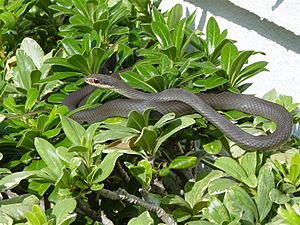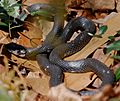Southern black racer facts for kids
Quick facts for kids Southern black racer |
|
|---|---|
 |
|
| Scientific classification |
|
| Kingdom: | Animalia |
| Phylum: | Chordata |
| Class: | Reptilia |
| Order: | Squamata |
| Suborder: | Serpentes |
| Family: | Colubridae |
| Genus: | Coluber |
| Species: | |
| Subspecies: |
C. c. priapus
|
| Trinomial name | |
| Coluber constrictor priapus Dunn & Wood, 1939
|
|
The southern black racer (Coluber constrictor priapus) is a common type of snake. It is not venomous, meaning it is not poisonous. You can find this snake in the southeastern parts of the United States.
Scientists gave it the name priapus because of a special feature on its body that helps them tell it apart from other snakes. These snakes are very active during the day, so you might often see them. They eat almost any small animal they can catch. This includes rodents like mice, frogs, toads, and lizards.
Southern black racers usually do not like to be held. Even if they have been with people for a long time, they often try to strike or wiggle a lot when picked up. They might also release a stinky smell, which is a common way for snakes to protect themselves from animals that want to eat them. Adult racers are usually thin with a shiny black back. Their belly is often gray, and their chin is white. They are very fast, which is why they are called "racers."
What They Look Like
These snakes are usually about 50 to 142 centimeters (20 to 56 inches) long. The longest one ever found was 183 centimeters (72 inches) long!
The southern black racer has a white chin. This helps tell it apart from an indigo snake, which usually has a dark or reddish-orange chin. Young southern black racers can have red or brown spots. These spots usually fade away as the snake gets older.
What They Eat
The southern black racer is a hunter. It eats lizards, insects, moles, birds, eggs, small snakes, rodents, and frogs. Even though its scientific name is Coluber constrictor, which sounds like "constrictor," this snake usually does not coil around its prey to squeeze it. Instead, it might press its victim into the ground or suffocate it quickly.
Sadly, many black racers are killed by cars on roads. Sometimes, people also hurt them because they are scared or mistake them for a dangerous snake. The southern black racer can look a bit like a cottonmouth, which is a venomous snake also known as a water moccasin. A cottonmouth has a white lining inside its mouth. Remember, racers are not venomous and do not breed with cottonmouths.
Natural enemies of the black racer include birds that hunt, like hawks. This includes the red-shouldered hawk and the broad-winged hawk. These birds have very good eyesight. They can fly high and then swoop down to catch black racers and other snakes. This makes the snake's speed on the ground not very helpful against them.
Images for kids













